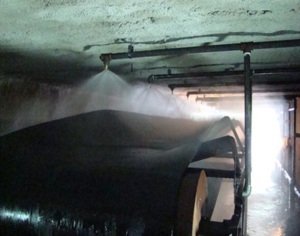Mining Topic: Fire Control and Suppression
What is the health and safety problem?
Fire in an underground coal mine is hazardous because of the confined space, possible effects on the ventilation system, and limited and long evacuation routes. Mine fires, in conveyor belt entries, can produce smoke and high levels of toxic gases that are carried throughout the mine by the mine ventilation system. Also, a fire in an underground coal mine with appreciable levels of methane can be especially dangerous, potentially causing a catastrophic explosion.
What is the extent of the problem?
The number of underground coal mine fires averaged 15 to 20 per year in the 1970s, but decreased to about 5 per year in the early 2000s. This decrease can be attributed to a number of factors, including the impact of fire research conducted by the NIOSH Mining Program. However, this number has increased to an average of 9 per year for the period from 2007 to 2009. It is believed that advances in mining technologies may be responsible for this resurgence.
How is the NIOSH Mining Program addressing this problem?

Fire suppression
To reduce the hazards of underground coal mine fires, particularly in conveyor belt entries, NIOSH is evaluating and applying recent technological advances in the areas of fire-resistant belt materials and belt fire suppression systems.
What are the significant findings?
Recent NIOSH studies have determined that the ventilation air velocity has a significant effect on the detection, activation, and suppression capabilities of mine fire detection and suppression systems.
What are the next steps?
NIOSH will investigate how airflow affects fire suppression systems in conveyor belt entries. This information, coupled with the findings from recent NIOSH studies, enables the mining industry to adjust their practices to mitigate any health and safety issues resulting from a change in mining practices. NIOSH will use modern fire computer codes developed for use in large, above-ground structures and supplement them with computation fluid dynamic (CFD) computer codes to evaluate suppression systems under current conveyor belt drive area configurations. The CFD codes and the new MFIRE 4.0 code will be used to model airflow and its interaction with the suppression system and agent. The goal is to develop more effective engineering designs for installation of fire detection and suppression systems.
- Effectiveness of Various Concentrations of an Inert Gas Mixture for Preventing and Suppressing Mining Equipment Cab Fires: Development of a Dual-Cab Fire Inerting System
- Evaluation of the Bagged Stone Dust Barrier Effectiveness in a Bord and Pillar Mine
- Fire Detection for Conveyor Belt Entries
- Fire Response Preparedness for Underground Mines
- Flammability of Wider Conveyor Belts Using Large-scale Fire Tests
- Impact of Air Velocity on the Detection of Fires in Conveyor Belt Haulageways
- Improvements in Conveyor Belt Fire Suppression Systems for U.S. Coal Mines
- Inflatable Partitions for High-Expansion Foam Generators
- Innovative Strategies for Mine Fire Preparedness
- MFIRE - 4.0.2.0
- Mine Fires - Measuring the Efficacy of Gas-Enhanced Foam
- Performance-Based Fire Safety Designs for Self-Escape in Underground Mines
- Remote Mine Fire Suppression Technology
- The Status of Mine Fire Research in the United States
- Understanding Mine Fire Disasters by Determining the Characteristics of Deep-Seated Fires